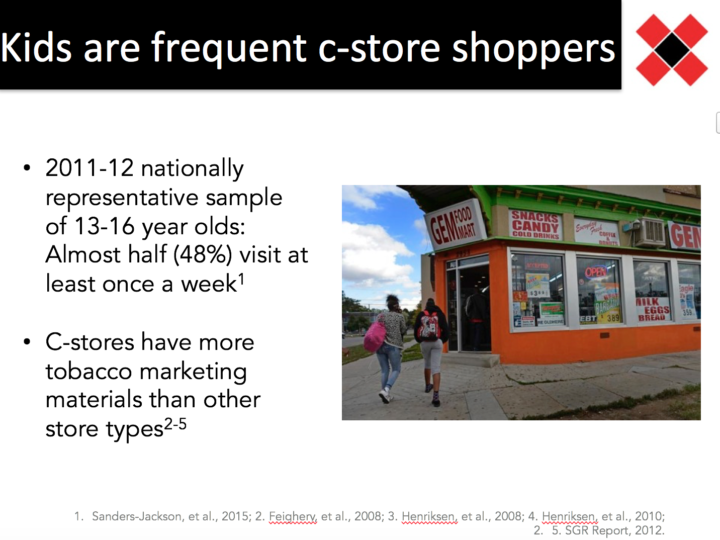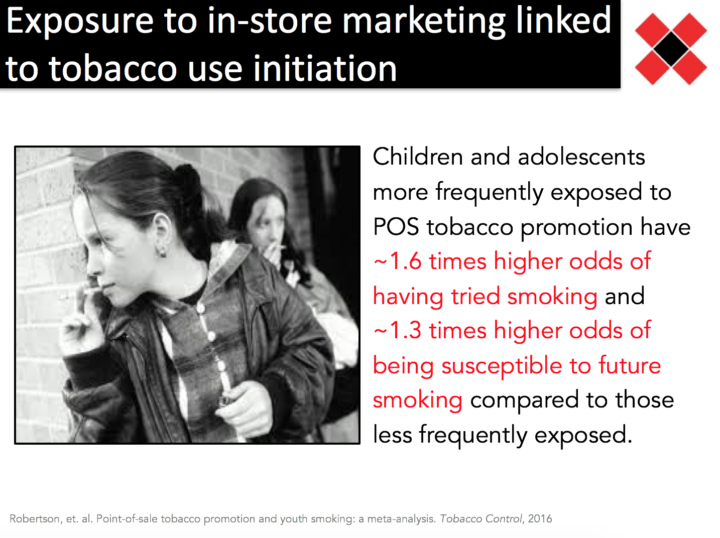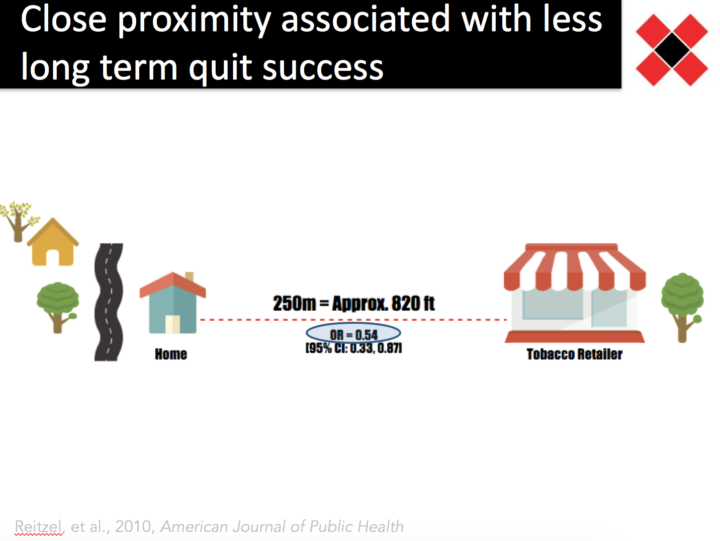Why Retail Tobacco Control Is Important
Tobacco control researchers and practitioners are often asked why working in the retail environment is important or necessary, especially in an era of resource constraints and competing priorities. This slide series helps make the case for retail. Go ahead, download the full slide deck in PPT or PDF form.
First, we must start in a typical convenience store in the United States.
Note the tobacco display units at the register; here, there are three (Marlboro, Camel, White Owl). You will also find tobacco product signs and price discounts. Products for sale include cigarettes, and non-cigarette tobacco products such as SNUS, e-cigarettes (Krave, in this picture), little cigars and cigarillos.
Also note the tobacco advertisements outside of the store.
Here we see newly hung tobacco advertising at a Family Dollar store, placed next to the kiddie ride and the Pepsi machine. Thank you to a Counter Tobacco visitor for uploading this image to our image gallery. 
Sometimes we see a “billboard effect” from the advertising. This is a powerful display.
Billboard advertisements for tobacco are no longer legal, however, placing a series of large signs together creates a billboard effect. These signs are prominently placed on the building exterior for kids and adults to know that both Slush Puppies and Winstons are sold inside, at “special” low prices. Imagine your child or neighbor walking by these advertisements on the way to school every day. That is a lot of brand impressions!
Retail is important to tobacco control advocates because retail is VERY important to the tobacco industry.
The tobacco industry spent over $7.3 Billion in 2020 at the point of sale, accounting for three quarters of the industry’s total marketing dollars. The money they spend in retail keeps advertisements prominent and prices low. These numbers come from the Federal Trade Commission (FTC) reports on Cigarette, Smokeless Tobacco, and E-Cigarette Sales and Marketing Expenditures; the largest tobacco companies are required to report their marketing, advertising and promotional spend to the FTC.
What are the impacts of all this spending at the Point Of Sale?
Researchers have demonstrated the impact of tobacco industry activity at the point of sale on health behaviors such as tobacco use initiation and relapse after a quit attempt. The next slides review the evidence.
Youth Initiation

Kids who shop frequently at convenience stores are more likely to start smoking than kids who do not shop frequently at convenience stores.
This evidence comes from a longitudinal study led by Dr. Lisa Henriksen, published in the journal Pediatrics in 2010. Dr. Henriksen and her team tracked middle schoolers over 12 months. All of the students did not smoke at the beginning of the 12 month period. At the end of the study, 18% of students had initiated smoking, but the incidence was 29% among students who visited convenience, liquor or small grocery stores at least twice per week and only 9% among those who reported the lowest visit frequency (less than twice per month). In other words, kids with the highest shopping frequency (2 to 8 visits per week) were 2.6 times more likely to start smoking than kids with the lowest shopping frequency. 
Advertisements and promotions in stores, together, create a pathway for kids to move from never-smoker to established-smoker.
A 2007 study investigated the influence of cigarette retail marketing on the movement of 8th, 10th and 12th graders in the US from experimentation to established smoking. Findings here show us that greater amounts of advertising in stores are associated with higher odds of initiating and becoming a “puffer”. Then, we see that movement from a puffer to an established smoker is helped along by greater numbers of promotions (price discounts and special offers) in the stores.
According to Lindsay Robertson’s 2016 meta-analysis, the amount of POS tobacco promotion materials that children and adolescents are exposed to correlates to their odds of trying smoking and smoking in the future.
Makes Quit Attempts More Difficult
Cigarette pack displays cue cravings.
Carter and team (2006) did a lab experiment where they showed smoking-related images (such as people smoking, lit cigarettes, and cigarette pack displays) or neutral content images to 63 research subjects who smoked at least 10 cigarettes per day. At the time of the study, some of the participants were nicotine deprived and others were not. Smoking related pictures produced significantly higher cravings than other picture types. All the smoking-related pictures increased craving compared with the neutral one. The picture of eight cigarette packs, a lot like a display, increased craving among both nicotine-deprived and non-nicotine deprived participants.

For people who smoke and people who have recently quit, cigarette displays at POS can prompt impulse purchase.
This study by Melanie Wakefield, published in Addiction in 2008, did phone interviews with about 600 Australian adults who smoke and recent quitters. Her team wanted to find out if removing cigarette pack displays would make it easier to quit. Findings were such that (1) people who smoked notice the cigarette pack displays (75%), (2) that ‘noticing’ gives them the urge to buy cigarettes (38%), and (3) some buy cigarettes even though they are trying to quit (61% of the 38% who got the urge).

Proximity & Density of tobacco retailers also impact health outcomes.
Proximity is a measure of the distance to nearest tobacco retailers in an area. It can be measured in feet, miles, or km; and can be radial or network buffers.
For those who have quit recently, their chances of success are reduced by about half if they live within 250 meters of a tobacco retailer.
Now we have some evidence that residential proximity to a tobacco retailer is correlated with a persons’ ability to stay quit. This study by Lorraine Reitzel and others from 2010 shows us that if a recent quitter lives within 250 meters of a tobacco retailer, his or her odds of staying quit over 6 months are half that of someone who does NOT live within 250 meters of a retailer. 
Density is a measure of the concentration or clustering of tobacco retailers in a defined area. It is measured as a number per 1000 people. For example, the national tobacco density average is 1.2 retailers per 1,000 people.
Stores near schools: Retailer density in school neighborhoods is associated with overall school smoking prevalence.
When there are more tobacco retailers in the school neighborhood, there is more smoking in the school. This is a finding from a cross-sectional study from Lisa Henrisken and team, published in 2008. The research team calculated the density of tobacco outlets within half-mile walking distance of 135 high schools in California, and also measured school smoking prevalence with questionnaires administered to students. What they found, is that school neighborhoods with high retailer density (>5 stores) had higher overall smoking prevalence (3.2%) than school neighborhoods with low retailer density or no retailers.

Proximity & Density Double Whammy!
Schools that have multiple retailers within walking distance (density & proximity) were found to have higher prevalence of smoking than schools with no retailers or low density of retailers.





